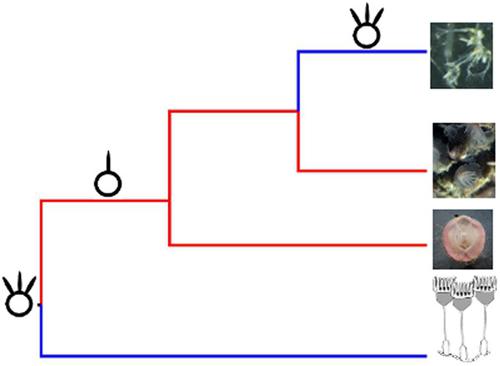当前位置:
X-MOL 学术
›
J. Exp. Zool. B Mol. Dev. Evol.
›
论文详情
Our official English website, www.x-mol.net, welcomes your feedback! (Note: you will need to create a separate account there.)
Genes with evidence of positive selection as potentially related to coloniality and the evolution of morphological features among the lophophorates and entoprocts
Journal of Experimental Zoology-B: Molecular and Developmental Evolution ( IF 2.2 ) Pub Date : 2020-07-08 , DOI: 10.1002/jez.b.22975 Scott Santagata 1
Journal of Experimental Zoology-B: Molecular and Developmental Evolution ( IF 2.2 ) Pub Date : 2020-07-08 , DOI: 10.1002/jez.b.22975 Scott Santagata 1
Affiliation

|
Evolutionary mechanisms that underlie the origins of coloniality among organisms are diverse. Some animal colonies may be comprised strictly of clonal individuals formed from asexual budding or comprised of a chimera of clonal and sexually produced individuals that fuse secondarily. This investigation focuses on select members of the lophophorates and entoprocts whose evolutionary relationships remain enigmatic even in the age of genomics. Using transcriptomic data sets, two coloniality‐based hypotheses are tested in a phylogenetic context to find candidate genes showing evidence of positive selection and potentially convergent molecular signatures among solitary species and taxa‐forming colonies from aggregate groups or clonal budding. Approximately 22% of the 387 orthogroups tested showed evidence of positive selection in at least one of the three branch‐site tests (CODEML, BUSTED, and aBSREL). Only 12 genes could be reliably associated with a developmental function related to traits linked with coloniality, neuroanatomy, or ciliary fields. Genes testing for both positive selection and convergent molecular characters include orthologues of Radial spoke head, Elongation translation initiation factors, SEC13, and Immediate early response gene5. Maximum likelihood analyses included here resulted in tree topologies typical of other phylogenetic investigations based on wider genomic information. Further genomic and experimental evidence will be needed to resolve whether a solitary ancestor with multiciliated cells that formed aggregate groups gave rise to colonial forms in bryozoans (and perhaps the entoprocts) or that the morphological differences exhibited by phoronids and brachiopods represent trait modifications from a colonial ancestor.
中文翻译:

具有阳性选择证据的基因可能与 lophorates 和 entoprocts 的殖民性和形态特征的进化有关
生物体殖民起源的进化机制是多种多样的。一些动物群体可能严格由无性萌芽形成的克隆个体组成,或由克隆和有性产生的个体的嵌合体组成,这些个体继发融合。这项调查的重点是 lohophorates 和 entoprocts 的选定成员,即使在基因组学时代,它们的进化关系仍然是神秘的。使用转录组学数据集,在系统发育背景下测试了两个基于殖民性的假设,以找到显示正选择证据的候选基因,以及来自聚合群体或克隆萌芽的孤立物种和分类群形成菌落之间可能会聚的分子特征的证据。在测试的 387 个正群中,大约 22% 在三个分支站点测试(CODEML、BUSTED 和 aBSREL)中的至少一个中显示出阳性选择的证据。只有 12 个基因可以可靠地与与殖民性、神经解剖学或纤毛领域相关的特征相关的发育功能相关联。正选择和会聚分子特征的基因测试包括径向辐条头的直向同源物,延伸翻译起始因子、SEC13和立即早期反应基因5。此处包括的最大似然分析导致基于更广泛的基因组信息的其他系统发育研究典型的树拓扑结构。需要进一步的基因组和实验证据来确定具有形成聚集体的多纤毛细胞的单独祖先是否在苔藓动物(可能还有 entoprocts)中产生了殖民地形式,或者 phoronids 和腕足类动物表现出的形态差异代表了殖民地的性状改变祖先。
更新日期:2020-07-08
中文翻译:

具有阳性选择证据的基因可能与 lophorates 和 entoprocts 的殖民性和形态特征的进化有关
生物体殖民起源的进化机制是多种多样的。一些动物群体可能严格由无性萌芽形成的克隆个体组成,或由克隆和有性产生的个体的嵌合体组成,这些个体继发融合。这项调查的重点是 lohophorates 和 entoprocts 的选定成员,即使在基因组学时代,它们的进化关系仍然是神秘的。使用转录组学数据集,在系统发育背景下测试了两个基于殖民性的假设,以找到显示正选择证据的候选基因,以及来自聚合群体或克隆萌芽的孤立物种和分类群形成菌落之间可能会聚的分子特征的证据。在测试的 387 个正群中,大约 22% 在三个分支站点测试(CODEML、BUSTED 和 aBSREL)中的至少一个中显示出阳性选择的证据。只有 12 个基因可以可靠地与与殖民性、神经解剖学或纤毛领域相关的特征相关的发育功能相关联。正选择和会聚分子特征的基因测试包括径向辐条头的直向同源物,延伸翻译起始因子、SEC13和立即早期反应基因5。此处包括的最大似然分析导致基于更广泛的基因组信息的其他系统发育研究典型的树拓扑结构。需要进一步的基因组和实验证据来确定具有形成聚集体的多纤毛细胞的单独祖先是否在苔藓动物(可能还有 entoprocts)中产生了殖民地形式,或者 phoronids 和腕足类动物表现出的形态差异代表了殖民地的性状改变祖先。

























 京公网安备 11010802027423号
京公网安备 11010802027423号